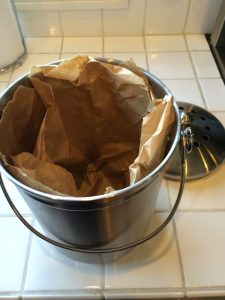Monday, April 22 is Earth Day. It’s a chance to reflect on our behavior – and try to take steps to improve the world we live in. Kind of like a New Year’s Resolution – for the environment. Here at WCI, we manufacture paper bags. So we tout the benefits of paper and how plastic trash is contributing to the “Great Pacific Garbage Patch.” But ALL trash is contributing to the rise of landfills and negatively affecting our planet. Anything put in a trash bag and picked up by the garbage truck is part of the problem – and that includes any paper products we throw away. A report from the Environmental Protection Agency (EPA) shows that Americans created 262.4 million tons of municipal solid waste (MSW) in 2015 – which has been on a steady upward trend since 1990. That’s an average of 4.48 pounds per person per day. Yikes! Check out some examples of how American trash is piling up in this article.
So what can we do? Specifically, let’s look at paper bags since that’s what we do here. Paper bags are a sustainable and renewable packaging option – and they biodegrade with no harmful impact on the soil. But what you do with the paper bag once it has delivered your items safely to your home is key. What are your options? We’re glad you asked! There are at least three: reuse it, recycle it, or compost it. All three have benefits – and they don’t have to be used independently of one another.
Reuse It.
Before considering recycling or composting, reuse that bag! Paper bags can be used many times. Use them to jot down your shopping list, wrap a gift, make crafts, and more. They can be cut, ripped, shredded, colored, stamped, glued and sewn. A simple internet search for “paper bag craft” will entertain you for hours on a rainy day.
If you’re not crafty, save paper bags to send leftovers home with the neighbors, protect counters while baking or painting, or to line a pet crate. Or use it to carry your lunch to school or work. Just don’t put it in the garbage can after a single use.
Recycle It.
Once you’ve used the bag to the maximum of it’s life, toss it in your recycling bin. It’s as simple as that. Nearly 70% of all paper products are recycled by consumers every year. According to the EPA’s most recent statistics, the total of MSW recycled in the United States was 67.8 million tons, with paper and paperboard accounting for approximately 67% of that number. Metals comprised about 12 percent, while glass, plastic and wood made up between 4 and 5 percent. Paper recycling is at its highest rate ever – and that doesn’t happen without your help. There are a few things to remember, though:
- If your paper bag was used to package food or soaps, remove any greasy areas by ripping them off before recycling them. Why rip off the oily spots? Paper isn’t heated during recycling, so grease and oils don’t break down and can cause contamination of the batch. Don’t throw things into the recycle bin just so you feel better that they weren’t in the trash. That’s called “wish-cycling” and it can do more harm than you’d think!
- Don’t recycle any paper bags with foil or poly lining like pet food bags. To see if a multi-wall paper bag can be recycled, try tearing it. If the layers come apart and they’re both paper it should be safe to recycle. If not, play it safe and reuse it for another purpose or throw it out.
Compost It.
 If you have an at-home compost site, or want to start one, paper bags are a great addition to your composting efforts. Referred to as “brown materials,” paper helps to add bulk and help allow air to better get into the compost. Brown materials are also the source of carbon in your compost pile. Carbon provides energy for microorganisms while they break down your organic matter like food scraps and yard waste.
If you have an at-home compost site, or want to start one, paper bags are a great addition to your composting efforts. Referred to as “brown materials,” paper helps to add bulk and help allow air to better get into the compost. Brown materials are also the source of carbon in your compost pile. Carbon provides energy for microorganisms while they break down your organic matter like food scraps and yard waste.
You can shred paper bags and put them directly in your compost bin or pile. Or, if you collect kitchen scraps for composting, line the compost bucket with paper bag or newspaper to make clean up a breeze. Then just toss the whole bag into the compost bin and break it up with a small spade, tear it into smaller pieces, or let it decompose naturally (it takes a little longer if left whole).
Some paper bags are not suitable for composting. Anything containing a “glossy” finish or large amounts of varnish or ink may be best recycled after it’s been used multiple times. Also – be sure to remove any non-paper handles or finishes from the bag before putting it in your compost pile.
Even if we’re not all at-home compost enthusiasts growing organic tomatoes and hugging trees, we can do our part to reduce waste. Do more with less. Reuse all of your packaging at least once. Recycle what you can – and do it the right way. For tips on proper recycling of all products, check out this helpful resource. You may be surprised at what you can – and can’t – recycle. I learned that you can recycle aluminum foil – something I’d previously been throwing away. If we all participate and improve our efforts, small choices can make a big difference in reducing our waste.
